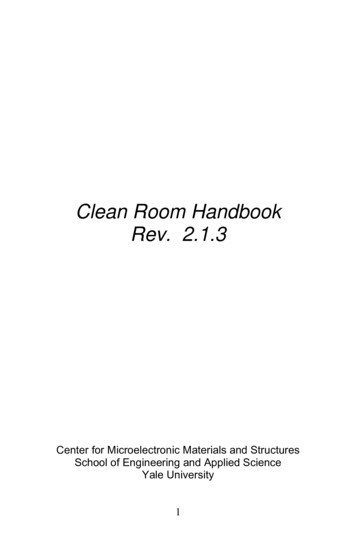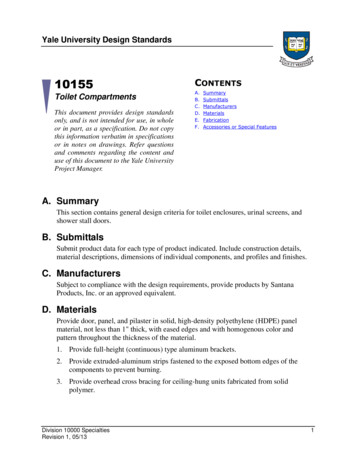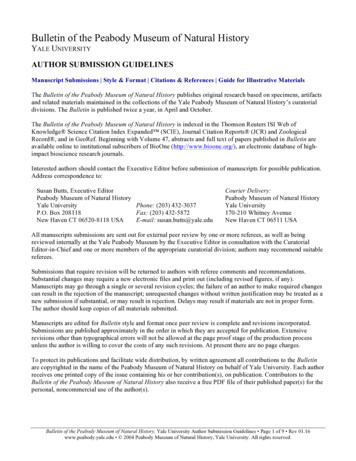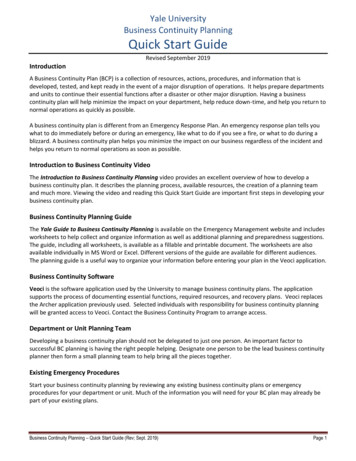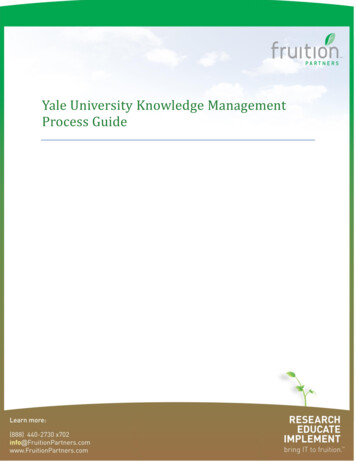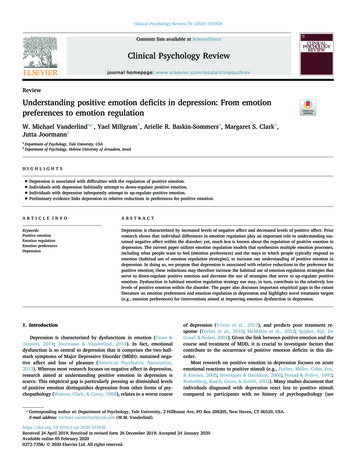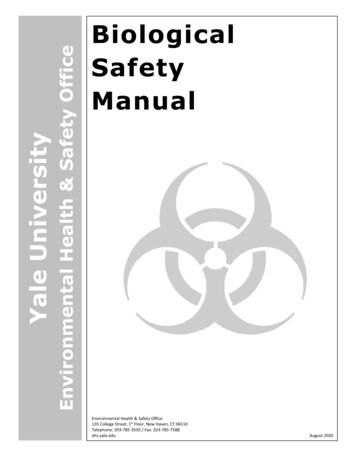
Transcription
Environmental Health & Safety OfficeYale UniversityBiologicalSafetyManualEnvironmental Health & Safety Office135 College Street, 1st Floor, New Haven, CT 06510Telephone: 203-785-3550 / Fax: 203-785-7588ehs.yale.eduAugust 2020
Exposure IncidentReport exposure immediately; you may need immediate therapy.Needle sticks/puncture wounds: Wash the affected area with antiseptic soap and warm water for 15 minutesMucous membrane exposure: Flush the affected area for 15 minutes using an eyewash.For all exposure incidents:Notify Principal Investigator, manager or supervisor (if available) to initiate accident or exposureincident report.Seek medical assistance immediately (within 1-2 hours) from Yale Health, Acute Care (432-0123).Medical Area employees may also go to the Y-NHH Emergency Room (688-2222) from 4:30 p.m.to 7:30 a.m. or Y-NHH Occupational Health Services, 688-2462, East Pavilion 1 - Room 40 (behindcafeteria) Mon. - Fri. excluding holidays 7:30 a.m. - 4:00 p.m.All employees should receive follow up care through Yale EmployeeHealth (432-7978)Emergency Phone NumbersPolice and Fire: 911Yale Health: 432-0123EHS Emergency Numbers8:30 a.m. to 5:00 p.m. Monday-Friday: 785-3555Other hours: 911
Table of ContentsForward . 11 . Introduction . 1-11.1 Emergency Phone Numbers and Environmental Health and Safety Contacts . 1-11.2 Responsibilities . 1-11.2.1Department Chairperson . 1-11.2.2Principal Investigator . 1-11.2.3Research Personnel . 1-41.2.4Environmental Health and Safety Office . 1-41.2.5Yale Biological Safety Committee . 1-52 . Biosafety Requirements . 2-12.1 Biological General Registration . 2-12.2 Human Pathogens . 2-12.3 Recombinant DNA Experiments . 2-22.4 Human Gene Transfer (HGT) . 2-22.5 Human Blood, Body Fluids, Tissue and Other Potentially Infectious Materials . 2-22.6 Animals . 2-32.7 Biosafety Cabinets (BSCs) and Other Laminar Flow Benches (LFBs . 2-42.8 Training . 2-43 . Medical Surveillance Program . 3-13.1 Tuberculosis (TB) Screening. 3-13.2 Immunizations. 3-23.3 Medical Restrictions . 3-23.3.1Pregnancy . 3-23.3.2Reproductive Biological Hazards . 3-23.3.3Other Restrictions . 3-33.4 Employee Serum Storage . 3-34 . Accidents . 4-14.1 Emergency Procedures for Exposure Incidents . 4-14.1.1Percutaneous Injury . 4-14.1.2Splash to Face . 4-14.1.3Aerosol Exposure. 4-14.2 Reporting Incident . 4-14.3 Medical Assistance . 4-14.4 Investigation of Laboratory Accidents . 4-15 . Risk Assessment and Risk Management . 5-15.1 Risk Assessment and Management Table . 5-55.2 Routes of Exposures . 5-75.2.1Routes of Transmission for Infectious Agents in the Laboratory . 5-105.3 Biosafety levels . 5-115.3.1Summary of Recommended Biosafety Levels for Infectious Agents . 5-126 . Signs and Labels . 6-16.1 Entryway Signs . 6-16.1.1Door Signs . 6-16.1.2Biosafety Level . 6-26.2 Biohazard Door Signs . 6-26.3 Labels . 6-46.4 Labeling Equipment Sent Out for Repair or Disposal . 6-4
7 . Laboratory Practices . 7-17.1 Human Factors and Attitudes in Relation to Laboratory Accidents . 7-17.2 Biosafety Level 1 . 7-17.3 Biosafety Level 2 . 7-27.4 Biosafety Level 2 . 7-27.5 Cell Culture . 7-37.6 Transport of Biohazards on Campus (between labs or buildings):. 7-37.7 Basic Microbiological Practices . 7-47.8 Housekeeping . 7-57.8.1Objectives of Housekeeping . 7-57.8.2Scope . 7-67.8.3Assignment of Responsibilities . 7-68 . Personal Protective Equipment (PPE) . 8-18.1 Laboratory Clothing . 8-18.1.1Gloves . 8-28.1.2Procedure for Removing Gloves. 8-28.1.3Shoes . 8-38.1.4Gowns, Lab Coats, Jumpsuits, Aprons and Other Protective Clothing . 8-38.1.5Face and Eye Protection . 8-38.2 Respiratory Protection . 8-48.3 Selection of PPE . 8-48.4 PPE Requirements Table . 8-69 . Laboratory Equipment . 9-79.1 Biological Safety Cabinets . 9-79.2 Procedures for Centrifugation. 9-79.3 Vacuum Line Chemical Traps and Filters . 9-89.4 Syringes and Needles . 9-99.5 Pipettes . 9-109.6 Blenders, Mixers, Sonicators, and Cell Disruption Equipment . 9-119.7 Lyophilizing . 9-119.8 Microtome/Cryostat . 9-129.9 Miscellaneous Equipment (Waterbaths, Cold Storage, Shakers). 9-1310 Decontamination and Disposal Procedures . 10-110.1 Decontamination Methods . 10-110.1.1 Heat . 10-110.1.2 Liquid Decontaminants . 10-110.1.3 Vapors and Gases . 10-110.2 Autoclave Procedure . 10-210.3 Characteristics of Chemical Decontaminants . 10-210.3.1 Properties of Some Common Decontaminants . 10-310.3.2 Selecting Chemical Disinfectants . 10-410.3.3 Characteristics of Some Liquid Disinfectants Table . 10-611 Spill Response . 11-111.1 Composition of a Basic Spill Kit . 11-111.2 Exposure Incident . 11-111.3 Biosafety Level 1 (BSL1) Spill . 11-211.4 Biosafety Level 2 (BSL2) Spill . 11-211.5 Blood Spills . 11-311.6 Spill in a Biological Safety Cabinet . 11-311.7 Centrifuge Spill . 11-311.8 Spill of a Biohazardous Radioactive Material . 11-411.9 BSL3 Spill Response Procedures . 11-6
12 Select Agents . 112.1 Possession, Use, or Transfer of Select Agents . 112.2 List of Select Agents and Regulated Toxins . 212.3 Tier 1 Select Agents . 312.4 Permissible Toxin Amounts . 412.4.1 Toxin due Diligence Requirements . 412.4.2 Reporting Suspected Violations or Suspicious Activity . 412.5 Registration of Possession, Use or Transfer of Select Agents. . 412.6 Discovery of Select Agents or Unknown Samples . 512.7 Intrafacility Transfer of Select Agents. 512.8 Destruction of Select Agents or Unknown Samples . 612.9 Additional Information . 613 Research Involving Recombinant and Synthetic Nucleic Acid Molecules . 13-113.1 Principal Investigator Responsibilities Under the NIH Guidelines. 13-113.1.1 Level of Review for rDNA Experiments . 13-213.2 Overview of Recombinant DNA Experiments Covered by The NIH Guidelines forResearch Involving Recombinant or Synthetic Nucleic Acid Molecules (NIHGuidelines) April 2019 . 13-313.2.1 Categories of rDNA Work That Require Registration . 13-313.2.2 Synthetic Nucleic Acid Experiments that are EXEMPT from the Guidelines . 13-713.3 Yale Biological Safety Committee Meeting rDNA Protocol Review . 13-913.4 NIH Definition of Synthetic Nucleic Acid Molecules . 13-1313.5 NIH OBA Exempt Experiment FAQs . 13-2113.6 NIH OSP Major Actions Under Sections III-A of the NIH Guidelines . 13-2513.7 NIH OBA Transgenic Animals and rDNA Use in Animals . 13-3013.8 Animal Experiments Covered Under the NIH Guidelines . 13-3513.9 NIH OSP FAQs on Incident Reporting . 13-3913.10 NIH OBA Investigator Responsibilities Brochure . 13-4114 Shipping . 14-114.1 Training . 14-114.1.1 Biological Materials and Dry Ice . 14-114.1.2 Chemical and Radioactive Materials . 14-114.2 Packaging. 14-114.3 Documentation . 14-114.4 Transport of Research Materials between Yale Campuses or Off Yale Campus . 14-114.5 Exports and Imports. 14-114.5.1 Exports . 14-114.5.2 Imports . 14-214.5.3 Table of Required Permits . 14-3Appendix ABiosafety Levels . 1Appendix BClassification of Human Etiologic Agents on the Basis of Hazard . 1Appendix CBSL2 Work Practices . 1Appendix DDual Use Research of Concern . 1Appendix ERegistration and Approval of rDNA Experiments - Poster . 1Appendix FHuman Gene Transfer Clinical Trials . 1Appendix G Sources of Contamination . 1Appendix H Biomedical Waste . 1Posters, Handouts, and Additional Information. IBSL1 Laboratory Practices .III
BSL2 Laboratory Practices . VCentrifuge Safety . VIIAutoc
Yale University Environmental Health & Safety Office Environmental Health & Safety Office 135 College Street, 1st Floor, New Haven, CT 06510 . Telephone: 203-
